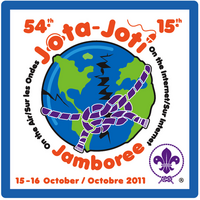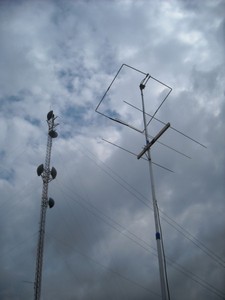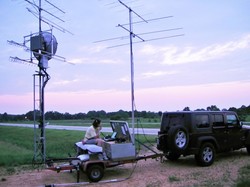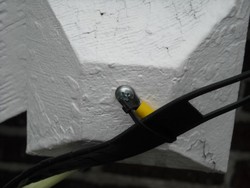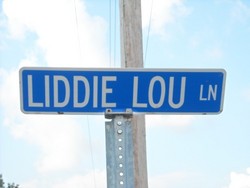 October 12, 2011 Editor: Ward Silver, NØAX | |||||||
IN THIS ISSUE
NEW HF OPERATORS - THINGS TO DO The largest phone contest of the year - CQ World Wide SSB - is right around the corner. It's the biggest sporting event the rest of the world has never heard of with 30,000 or more individual participants! Before filling your log with DX, the ARRL School Club Roundup and Jamboree On the Air are great ways to make contact with our younger operators - give them a call! BULLETINS There are no bulletins in this issue. BUSTED QSOS The editor is blissfully unaware of any sins of commission or omission in the last issue. CONTEST SUMMARY Complete information for all contests follows the Conversation section Oct 15-16
Oct 22-23
Happy birthday to the legendary Parkes radio telescope antenna - thanks for 50 years of service as of 31 October! Seen in the movie, "The Dish" (highly recommended - Ed.), the antenna was a crucial element in the early years of the United States' manned space program. 64 meters across, the facility is located in New South Wales, Australia, not far from its namesake town. Your Noise is My Command is a paper on using the body as a sense antenna for touch-type control explores the electromagnetic environment of the typical home. It makes for very interesting reading as to how the RF "fog" can be used as the basis for control by using gestures. No word on what happens when strong local contest-style RF is about but perhaps our emissions could eventually change from bugs to features! (Thanks, Brian K1BRF)
Eminently less approachable than the BBC's programmes, the Russian Short Wave Radio Enigma was featured in a recent Wired magazine story. The station, on 4625 kHz LSB if you're interested, transmits what are thought to be messages to a far-flung espionage empire. "Ham's Eye View" - a blog on ham radio-related topics - has been inaugurated for the electrical and electronic engineering magazine EDN in their website's Planet Analog section. The author is WRTC 2014 chair and perennial inhabitant of Top Ten contest results, Doug Grant, K1DG. George VE3ERP is retiring from maintaining his HAMCALC package of calculators for radio problems. Updating the literally dozens of small utilities to run with current operating systems may be under way by other volunteers but for now development will stop at the current version, 129. We thank George for his years of service (the package was first released in 1995) and the valuable contribution to ham radio! In between the great openings on the high bands, a contest that is running 24/7 is just over your heads. The ARISSat-1 satellite has a lot of orbits left before it hits the skids, so to speak, but if you have a good prediction for the date of its demise, you should enter the ARISSat Chicken Little Contest which ends on Oct 15th, possibly along with ARISSat-1. While it's still whirling around up there, ARISSat-1 is transmitting the call signs of famous hams via CW on 145.92 MHz. Copy those call signs and enter the CW contest with information as shown at the satellite's website. This might be especially fun for student teams! (Thanks, AMSAT bulletin ANS-282) Tiny San Marino, T7, is one of the world's smallest DXCC entities. (Quick! What are the other two nano-entities within the borders of Italy. Answers below...) This NY Times story provides some interesting background on one of our favorite multipliers. (Thanks, Brian N9ADG) Citigroup researchers might want to listen to 20 meters during the upcoming CQ WW SSB contest before deciding there might not be a spectrum shortage. There seems to be quite a bit of spectrum that was purchased speculatively but is as yet unused. If you want to give a little emphasis in an email without coming across as shouting, here's a suggestion: Place asterisks around what you want to be noticed - for example, *notice this* instead of NOTICE THIS. Many browsers, wikis, and other text-display software will display text between asterisks in bold font. This lets you get your point across more politely. Of course, if you really WANT to shout, the CAPS LOCK key is just a pinky away.
If you are looking for Jamboree On the Air stations this weekend, here's a link to the Boy Scouts of America information page that includes an updated list of stations registered for JOTA activity. Web Site of the Week - Long may it wave...but not much longer. The transmissions of BBC's station Radio 4 on 198 kHz emanate from a pair of meter-high "valves" that are irreplaceable. Once the remaining store of the big bottles is gone, the broadcasts may well go dark. On the air since 1926 and serving areas out of range of FM stations, transmission moved to 200 kHz in 1934 and then to 198 kHz where it can be found today. (Thanks, Tomas NW7US) WORD TO THE WISE Acrostic - The last issue's wonderings about "hamonyms" made from the letters of a call sign prodded Paul WB2ABD to respond, "I believe those are called "acrostics"." That's as close as I've seen - perhaps we should call them "hamcrostics". Last week's webinar, "CQ WW Update 2011" hosted by K3EST, KR2Q, and K1AR is now available on the Potomac Valley Radio Club's website under the "Recorded Webinars" link. (Thanks, Ken K4ZW)
The recent Pacific NW VHF Society convention was held in scenic Bend, Oregon and well-documented in this Picasa photo album. Check out the double-rainbow-sunrise picture! Other pictures put faces behind familiar call signs from the Northwest - good job, host committee! (Thanks, Barry WA7KVC) If you think you might want to see what the rocket sees, here's a terrific video from within Derek Deville's Qu8k ("quake") as it ascends from the floor of the Nevada desert to 121,000 feet in a few seconds - an attempt to claim the Carmack Prize. This would definitely be in the High Power category! The extended version of the 2011 ARRL June VHF QSO Party results - an excellent piece by Rick K1DS - will be online in a day or two for your reading enjoyment! There is a very nice adventureroverama by Steve N2CEI and Sandra K4SME, as well. (Thanks, ARRL Contest Branch Manager, Sean KX9X)
Chris 9A5K has developed new contest log processing software for the latest EU Spring Sprint contests. The results for CW and Phone are now online. (Thanks to the EU Sprint Committee) Those two entities are: 1AØ (Sov. Order of the Knights of Malta) and the Vatican (HV). OPERATING TIP Pat WW9R contributes this tip for computer logging - "I find it helpful to run a strip of masking tape above the Function keys and mark what each one does. Then, in the heat of the battle or when you get really tired, you can find all the messages! I fill all available CW messages with something like "73""GL" "?" "AGN" and the individual parts of the exchange; sometimes a slowed-down version of the exchange so I don't need to touch the CW speed setting." Howie WA4PSC posted this extended set of instructions that describe the broadcast industry standard for weatherproofing coaxial cable connections. Adapt to your own circumstances. When sealed correctly in the following manner the weatherproofing will last for years and withstand just about any weather. When cut open for service, the mated connected pair will be dry and shiny. This is the broadcast industry standard - others may have different methods that work well for them so the usual caveats apply. Since ham radio is a hobby, there is less financial pressure to make installations bulletproof but if the weatherproofing fails atop a tower in the dead of winter, you will rue the day you didn't do the job right.
1) Arrange the cable so that it can form a drip loop near the connector. Keeping water away from the connector is important. Support the cable at or near the drip loop to reduce flexing at the connector which can cause weatherproofing failure. 2) Thoroughly clean the connector body/cable/antenna connector body where the weatherproofing will be applied. Adhesion is greatly degraded by dust or grease. 3) Lay down a flat, non-wrinkled single layer of 3/4" Scotch electrical tape extending several inches out on the cable jacket and/or antenna connector and covering the mated connector bodies. This provides a clean surface for the self-fusing butyl tape layer and protects the connectors from the butyl adhesive. Some recommend flipping the initial layer upside-down over the connector to keep adhesive residue off of the connector bodies but in my experience this is a non-issue if quality tape is used, such as Scotch 33+ or 88+. 4) Apply a layer of self-fusing butyl tape, stopping an inch from each end of the initial layer. This is the main waterproofing layer, so it is important to keep the butyl warm and thoroughly massage it into a homogenous mass around the the connector assembly. In the winter, keep the rolls of tape and butyl inside your jacket or your arm pit until use. It is also important to press it into grooves and attempt to mold the outside surface of the butyl into as smooth a cylinder as possible. If this is not done, the top layer of tape will not lay flat and allow moisture ingress as well as allow the butyl to be exposed to the weather. Make the transition from the cylindrical mass of butyl to the cable as smooth as possible. 5) On top of the butyl, wrap several layers of 2" wide electrical tape extending past the bottom layer of tape on both ends of the connector assembly. Use low tension to ensure the type is wrinkle-free and flat against the butyl and cable/antenna body. Do NOT wrap the tape tightly; when the assembly heats up in the sun the tension exerted by the tape will begin to extrude the butyl between the tape layers. The final 6" of outer tape should be applied with very little tension so as not to put shear on the usupported adhesive. The end of the tape must be cut, not torn, so there is no distortion or residual stress in the tape. Wrap the final turns carefully, do NOT get dust, dirt, finger or other greases on the adhesive and make sure the end of the tape lands flat and with zero tension. If it pulls up for any reason, the "flag" it forms will catch the wind and eventually compromise the assembly. I have settled on using Andrew #221213 weatherproofing kits which cost less than $20 each, include quality Scotch tape and can weatherproof one 3" Heliax, two 1-5/8" Heliax, four 7/8" Heliax or at least six or more 1/2" UHF/N connectors with each kit (they claim 12). I have had other tower riggers say that the Wireless Solutions WK-U kit also works well. Either kit contains materials which pass MIL-STD-1344A, Method 1002 for weather resistance. Occasionally "aneurysms" develop in the weatherproofing from trapped air bubbles caused by pressure from the inside of the cable when using UHF connectors which are not pressure tight. This pressure is caused by thermal cycling and air expansion. According to Andrews, placing gel weatherproofing compound in connectors is also not recommended as it can soften the gaskets in connector bodies, as well as be forced under expansion through the tape and contribute to degradation of the weatherproofing.
It is common for ham antenna installs to feature multiple connectors close together where you cannot wrap tape successfully. In those cases, the dual-layer hot-melt-lined heat-shrink is often used. Getting this technique right may take some experimentation. The biggest problem with the use of adhesive-lined heat-shrink in this application is that the polymer used for the melting liner becomes quite rigid at low temperatures and may release from cable jackets when mechanically stressed by cable movement. The vinyl/butyl tape solution in general will not. In either case, adequately supporting the cable close to the connection will greatly help the longevity of the connection. Break Out the Clubs As the fall contest season gets into full roar, don't miss the opportunity to get your club members involved, especially those who are generally on the sidelines. There is nothing like a club challenge or mini-contest or even a set of hand-labeled whisk brooms to encourage those new to radiosport to give it a try. The new ARRL Sweepstakes Contest Manager, Larry K5OT has some words of wisdom for clubs - pass it on! 73, Ward NØAX Clubs are always looking for operating events and opportunities that excite and motivate their members to be active, especially on HF. This year's ARRL November Sweepstakes certainly fits the bill and - for the first time in years - the bands will have plenty to offer Technician license-holders, too! Sweepstakes - or "Sweeps" among friends - is a contest in which modest stations can do very, very well. There's no need for giant towers and antennas or legal-limit amplifiers - a backyard dipole or vertical and a "barefoot" HF rig will do just fine. In fact, SS is one contest in which antennas can be too high! Because Sweepstakes brings out so many US and Canadian operators, it is very popular for friendly "contests within a contest" between clubs and between club members. A club contest to work the most sections, make Worked All States, or ring up the highest score is a nice way to wrap up the season with awards being presented at the year-end meeting. Many clubs have a friendly competition with other nearby clubs for local bragging rights. Even small clubs can get into the action on a national scale in the Local category of the ARRL Affiliated Club Competion. College clubs can participate in two ways. The first is to submit a score in the School Club category of the main competition. With its 30-hour time limit, the shared-operating nature of the category fits right in with the busy fall semester. Give the Phone weekend (Nov 19-20) a try before heading home for Thanksgiving break! The second is to participate in the Collegiate Championship, sponsored by Ken Harker, WM5R. Ken has compiled a long list of yearly winners for each of the NCAA Division I Conferences - has your school's club participated? The website is currently being updated with the 2010 scores and we need some help sorting out the current conference assignment for the record-holders - any volunteers? Finally, for a relaxed "practice" opportunity, try the ARRL's School Club Roundup from Oct 17-21. Did we mention the opportunities for Technician licensees? Techs have a large chunk of 10 meters available to them on both Phone and CW but in recent years, there hasn't been much activity due to quiet solar conditions. Lately, the solar flux has been kicking up to 120 and higher, meaning that 10 meters opens up coast-to-coast and beyond! If your club's Techs have been wondering what all the fuss is about 10 meters, be sure to encourage their activity during Sweeps. Perhaps one of those intra-club challenges we were talking about? If you'd like to know more about Sweepstakes, download the Sweepstakes Operating Guide - there are simple explanations of the rules and a list of resource articles and websites to help you get the most from your Sweepstakes weekend. Maybe you'll even bring home the coveted "Clean Sweep" coffee mug! CQ Sweeps! 12 October through 25 October An expanded, downloadable version of QST's Contest Corral in PDF format is available. Check the sponsor's Web site for information on operating time restrictions and other instructions. HF CONTESTS NAQCC Monthly QRP Sprint--CW, from Oct 12, 0030Z to Oct 12, 0230Z. Bands (MHz): 3.5-14. Monthly on 2nd Tuesday or 3rd Wednesday local time (alternating). Exchange: RST, S/P/C, and NAQCC mbr nr or power. Logs due: 4 days. Rules CWops Monthly Mini-CWT Test--CW, from Oct 12, 1300Z, see website. Bands (MHz): 3.5-14.Multiple operating periods, twice monthly on 2nd and 4th Wed, 18 to 28 kHz above band edge. Exchange: Name and member number or S/P/C. Logs due: 2 days. Rules Great Pumpkin Sprint--Digital, from Oct 15, 8 PM to Oct 16, 2 AM. Bands (MHz): 1.8. Exchange: RST and S/P/C. Logs due: Nov 15. Rules JARTS WW RTTY Contest--Digital, from Oct 15, 0000Z to Oct 16, 2400Z. Bands (MHz): 3.5-28. Exchange: RST and age (YL may send '00'). Logs due: Nov 30. Rules 10-10 Fall CW QSO Party--CW, from Oct 15, 0001Z to Oct 16, 2359Z. Bands (MHz): 28. Exchange: Call, name, 10-10 number, S/P/C. Logs due: Oct 31. Rules QRP ARCI Fall QSO Party--CW, from Oct 15, 1200Z to Oct 16, 2400Z. Bands (MHz): 1.8-28. Exchange: RS(T), S/P/C, QRP ARCI number or pwr. Logs due: Nov 16. Rules Iowa QSO Party--Phone,CW,Digital, from Oct 15, 1400Z to Oct 15, 2300Z. Bands (MHz): 1.8-28, 50+. Exchange: RS(T) and IA county, state/prov, or "DX". Logs due: Nov 15. Rules New York QSO Party--Phone,CW,Digital, from Oct 15, 1400Z to Oct 16, 0200Z. Bands (MHz): 1.8-28, 50+, Frequencies: CW--1.820, 3.550, 7.050, 14.050, 21.050, 28.050; Phone--1.870, 3.825, 7.200, 14.290, 21.350, 28.400. Exchange: RS(T), NY county, state/prov, or "DX". Logs due: 14 days. Rules Worked All Germany--Phone,CW, from Oct 15, 1500Z to Oct 16, 1459Z. Bands (MHz): 3.5-28. Exchange: RS(T) and serial or DOK code. Logs due: 14 days. Rules Asia-Pacific Sprint--CW, from Oct 16, 0000Z to Oct 16, 0200Z. Bands (MHz): 14-21. Exchange: RST and serial. Logs due: 7 days. Rules Illinois QSO Party--Phone,CW, from Oct 16, 1700Z to Oct 17, 0100Z. Bands (MHz): 1.8-28, 50,144. Exchange: RS(T) and IL county or S/P/C. Logs due: Nov 17. Rules Spooky Feld-Hell Sprint--Digital, from Oct 16, 2000Z to Oct 16, 2200Z. Bands (MHz): 3.5-7,21-28. Exchange: RST, S/P/C, Feld-Hell member nr. Logs due: 2 weeks. Rules Run For the Bacon--CW, from Oct 17, 0200Z to Oct 17, 0400Z. Bands (MHz): 1.8-28. Monthly on 3rd Sunday night (local). Exchange: RST, S/P/C, Flying Pig nr or power. Rules School Club Roundup--Phone,CW,Digital, from Oct 17, 1300Z to Oct 21, 2359Z. Bands (MHz): 1.8-28, 50+. Exchange: RST, class and S/P/C. Logs due: 30 days. Rules FOC QSO Party--CW, from Oct 22, 0000Z to Oct 22, 2359Z. Bands (MHz): 1.8-28. Exchange: RST, name, and FOC number if member. Logs due: 7 days. Rules Scandinavian YLRA Contest--Phone,CW,Digital, from Oct 22, 1000Z to Oct 23, 1000Z. Bands (MHz): 3.5-28. Frequencies: See website. Exchange: RS(T) and "88" (YLs) or "73" (OMs). Logs due: Nov 30. Rules Stew Perry Warmup Contest--CW, from Oct 22, 1500Z to Oct 23, 1500Z. Bands (MHz): 1.8. Exchange: 4-char grid square. Logs due: Nov 18. Rules W/VE Islands QSO Party--Phone,CW,Digital, from Oct 22, 1600Z to Oct 23, 2359Z. Bands (MHz): 1.8-28, 50. Exchange: RS(T) and S/P/C or island designator. Logs due: Nov 30. Rules VHF+ CONTESTS ARRL EME Contest--Phone,CW,Digital, from Oct 22, 0000Z to Oct 23, 2359Z. Bands (MHz): 50-1296. Exchange: Call signs, sig rpt, acknowledgement. Logs due: Dec 20. Rules Fall VHF Sprints--Phone,CW,Digital, from Oct 22, 7 AM to Oct 22, 1 PM. Bands (MHz): 902+. Exchange: 6-character grid locator. Logs due: 4 weeks. Rules Arucaria VHF Contest--Phone,CW, from Oct 15, 0000Z to Oct 16, 1600Z. Bands (MHz): 50,144. Exchange: RS(T) and 4-char grid square. Logs due: 10 days. Rules Iowa QSO Party--Phone,CW,Digital, from Oct 15, 1400Z to Oct 15, 2300Z. Bands (MHz): 1.8-28, 50+. Exchange: RS(T) and IA county, state/prov, or "DX". Logs due: Nov 15. Rules New York QSO Party--Phone,CW,Digital, from Oct 15, 1400Z to Oct 16, 0200Z. Bands (MHz): 1.8-28, 50+, Frequencies: CW--1.820, 3.550, 7.050, 14.050, 21.050, 28.050; Phone--1.870, 3.825, 7.200, 14.290, 21.350, 28.400. Exchange: RS(T), NY county, state/prov, or "DX". Logs due: 14 days. Rules Illinois QSO Party--Phone,CW, from Oct 16, 1700Z to Oct 17, 0100Z. Bands (MHz): 1.8-28, 50,144. Exchange: RS(T) and IL county or S/P/C. Logs due: Nov 17. Rules Illinois QSO Party--Phone,CW, from Oct 16, 1700Z to Oct 17, 0100Z. Bands (MHz): 1.8-28, 50,144. Exchange: RS(T) and IL county or S/P/C. Logs due: Nov 17. Rules W/VE Islands QSO Party--Phone,CW,Digital, from Oct 22, 1600Z to Oct 23, 2359Z. Bands (MHz): 1.8-28, 50. Exchange: RS(T) and S/P/C or island designator. Logs due: Nov 30. Rules LOG DUE DATES 12 October through 25 October
ARRL Information Click here to advertise in this newsletter. Your One-Stop Resource for Amateur Radio News and Information ARRL membership includes QST, Amateur Radio's most popular and informative journal, delivered to your mailbox each month. Subscribe to NCJ - the National Contest Journal. Published bimonthly, features articles by top contesters, letters, hints, statistics, scores, NA Sprint and QSO Parties. Subscribe to QEX - A Forum for Communications Experimenters. Published bimonthly, features technical articles, construction projects, columns and other items of interest to radio amateurs and communications professionals. Free of charge to ARRL members: Subscribe to The ARRL Letter (weekly digest of news and information), the ARES E-Letter (monthly public service and emergency communications news), Division and Section news -- and much more! ARRL offers a wide array of products to enhance your enjoyment of Amateur Radio. Visit the site often for new publications, specials and sales. Donate to the fund of your choice -- support programs not funded by member dues! ACKNOWLEDGEMENTS ARRL Contest Update wishes to acknowledge information from WA7BNM's Contest Calendar and SM3CER's Contest Calendar. | |||||||

